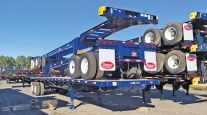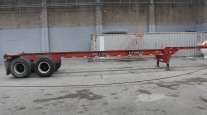Chassis Responsibility Changes Cause Difficulties for Carriers
This story appears in the Sept. 6 print edition of Transport Topics.
Intermodal fleets expect a tough financial and operational transition period as ocean carriers move the responsibility for chassis onto carriers that make international cargo deliveries, according to several carrier officials.
Chassis strategies began to change last year when the biggest ocean carrier, Maersk Line, began renting them. These changes have had a profound effect on truckers because ocean carriers own or lease 85% of U.S. chassis. Since then, other major maritime carriers such as CMA-CGM announced plans to exit the chassis market.
Fleets report mixed success with one key issue — getting customers to pay fees such as the $11-a-day rental charged by Maersk’s Direct Chassis Link.
“Customers, for the most part, are paying the charges,” said Chris Giltz, senior vice president of operations for Evans Delivery, a Schuykill Haven, Pa.-based trucking company. “We are not seeing any significant issues from the customer side.”
On the other hand, Mike Shelton, CEO of Roadlink, said there has been some “pushback” that the carrier is addressing with customers.
At the same time, fleets are weighing how, when and if they should become chassis owners.
“If the system is working fine, and there is no issue of availability, we might decide not to buy any,” said Giltz.
“If we wind up with no steamship line owning chassis and us on the open market renting them, then we can choose the provider who gives us the best combination of price and service.”
Some think it’s too soon to move.
“It would be premature to go out and buy chassis,” said Tom Adamski, president of First Coast Logistics. “There are bargains out there, but there aren’t enough rules yet. You’d be rolling the dice to make any big purchases.”
“There are many different criteria that will determine whether a motor carrier will own, long-term lease or rent chassis on a daily basis,” said Steve Rubin, CEO of TRAC Intermodal, which last year began a leasing program as an alternative to Maersk.
He said fleets have to weigh buying versus leasing choices, as well as funding sources such as capital or credit lines.
Jim Apa, president of Fore Transportation, had another view.
“You can go with Direct Chassis Link and use their chassis for $11 a day,” the carrier executive said. “If I come in [to a Maersk terminal] with someone else’s equipment, I get charged a lift fee of $50 to $100.”
Apa said he loses money using DCL because he has to carry that fee as a receivable until the customer pays.
“I could buy my own chassis and charge $11 a day, but then I would be in the chassis business and I don’t want to do that,” he said. “So, you’re better off staying with Direct Chassis Link and not fighting City Hall.”
Shelton said RoadLink is trying to evaluate the costs and benefits. “Clearly we are not in a position to absorb the costs,” he said.
Shelton continued: “We are working pretty closely with steamship lines to understand their strategy. The discussions have clearly escalated since June. In the next 30 days we will have our strategy fully vetted.”
The same thorny questions surfaced on the operational side.
“There will be a lot of reluctance on the truckers’ part to leave their chassis at yards,” Adamski said. “There will have to be changes in the facilities.”
The transition will take longer at terminals that store chassis in parking areas instead of stacking them, said Tioga Group consultant Dan Smith. That’s because draymen waste time looking for the right chassis when they are parked instead of stacked.
“The system for pickups and deliveries isn’t efficient now,” Pacer Cartage President Val Noel said, which hurts productivity. “Now, if we are going to have to wait to get equipment mounted and remounted on chassis, that could make the situation worse.”
Some optimism accompanied the concern.
“There is probably money to be made, but there are a lot of issues surrounding chassis,” Giltz said, highlighting issues such as maintenance.
“Hopefully, the system will work and everything will be fine,” he added.
Noel said he was “cautiously optimistic” because “at the end of the day, [assuming chassis responsibility] is going to force all carriers to be more financially responsible. This is going to force truckers to be more disciplined.”
“The more enduring drayage companies will figure out how to do this,” Smith said. “They can get access to capital. Intermodal truckers are very aggressive entrepreneurs with very sharp pencils. I have full faith they will figure out a solution.”
When that might happen is unknown. “We are not the drivers in this,” Giltz said. “We are just reacting to the changes. How this will take to shake out depends on the steamship lines.”




